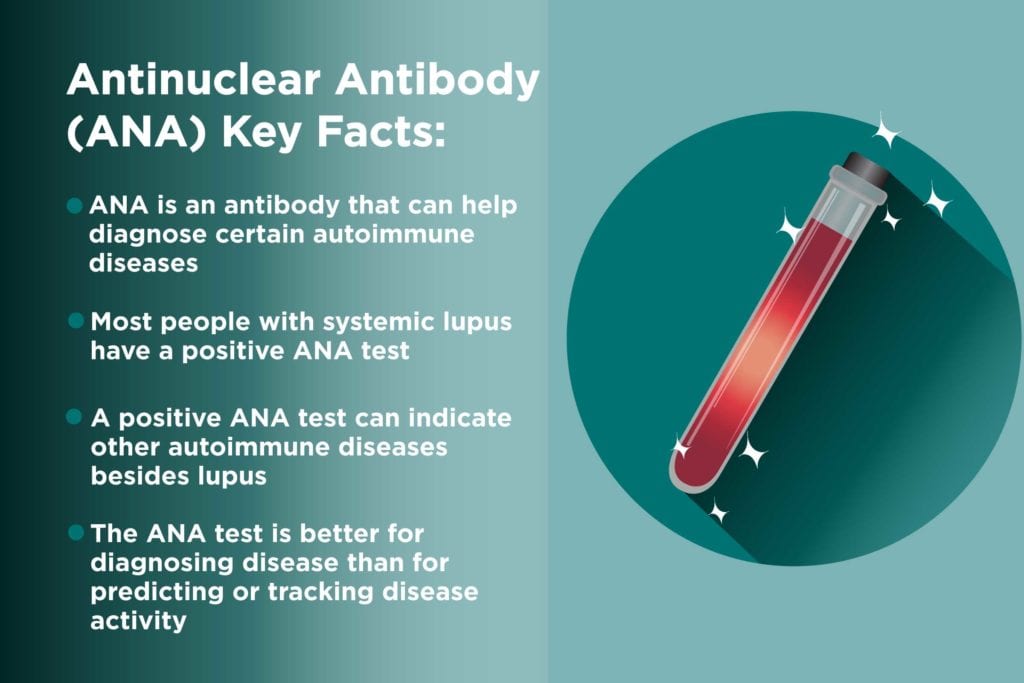

Lupus and other inflammatory diseases can be challenging to diagnose because they don’t usually have a single definitive test. Instead, as part of the diagnosis process, doctors will order several blood tests to measure levels of inflammation, the presence of various antibodies, and more.
The antinuclear antibody (ANA) test is one of many blood tests that your rheumatologist might order to help guide the diagnosis.
What Is the ANA Blood Test?
Your immune system produces proteins called antibodies to fight off foreign cells like bacteria and viruses, which keeps you from getting sick. Antinuclear antibodies are a category of antibodies that targets the nucleus of other cells. Your body will produce ANAs naturally to fight off infections, but in certain autoimmune conditions, the body produces ANAs even when there isn’t an invader.
With no germs or foreign cells to fight off, the antibodies attack the body’s own cells instead, driving inflammation that causes joint pain and other symptoms. Doctors use the ANA blood test to help diagnose certain autoimmune conditions, particularly lupus.
What Do the Results of the ANA Blood Test Mean?
After your blood is drawn, it’s sent to a lab, where it’s diluted with saline solution and tested for the presence of antinuclear antibodies. Up to 15 percent of healthy people without any autoimmune disease will test positive for ANA, so labs go a step further to see just how much ANA is there. They’ll water down the blood more and more until the test comes back negative. When a sample is very diluted but still comes back positive, it tells doctors there’s a higher level of ANA in the blood — and a higher chance that autoimmune problems are driving that number up. “The greater that dilution is that you still see presence of ANAs, the higher the likelihood of clinical relevance is,” says Christopher Collins, MD, attending rheumatologist and program director of the Rheumatology Division at MedStar Washington Hospital Center in Washington, D.C.
How Sensitive and Specific Is the ANA Test?
ANA tests are very sensitive, which means they’re good at identifying “true positives.” According to the Johns Hopkins Lupus Center, 98 percent of people with systemic lupus will have a positive ANA test.
A positive ANA test isn’t necessarily a guarantee of lupus though. Positive ANA tests can also indicate other autoimmune diseases, such as scleroderma or Sjogren’s syndrome. And some healthy people have naturally high levels of ANA; the likelihood of this increases with age. Up to one in three people over age 65 have a positive ANA result, according to MedlinePlus.
On the other hand, the ANA test isn’t very specific, which means that the results aren’t as good at identifying “true negatives.” According to a 2015 study, an ANA test of a 1:80 blood-to-saline sample has a specificity of 78 percent for systemic lupus. This indicates that 78 percent of people who do not have lupus will test negative, but the other 22 percent of people without the condition might test positive.
Bottom line: The high sensitivity and lower specificity of the ANA test means most people with lupus will have a positive ANA test, but not everyone with a positive ANA test has lupus.
What Diseases Does the ANA Test Help Diagnose?
An ANA test result is just one piece in the puzzle for diagnosing autoimmune conditions. It’s generally associated with lupus, though a positive ANA result can also be a sign of Sjogren’s system, scleroderma, liver disease, and more. “If you have a positive ANA, that’s when rheumatologists use their experience to tie in clinical signs and symptoms to do more clinical testing to better define the clinical disease, if there is one,” says Dr. Collins.
With a positive ANA test result, you’ll likely need to get more blood drawn for additional tests that look for for more specific types of ANAs. Specific types of antinuclear antibodies, like the anti-double-stranded DNA antibody (anti-dsDNA) and anti-Smith (anti-Sm), both associated with SLE, and the Scl-70 (associated with scleroderma), are more strongly associated with particular diseases than a general ANA test is.
What Diseases Does the ANA Test Help Rule Out?
Even though a positive ANA result can’t definitively diagnose lupus or other diseases, a negative result can help a doctor to eliminate certain conditions. “A negative ANA test in a patient with a relatively low probability [of lupus] helps you say, ‘No, this isn’t lupus,’” says Dr. Collins. “But a positive test alone isn’t enough to point you in any specific direction.” The doctor will have to put the ANA test result in context with the rest of the patient’s history, symptoms, and other test results before making a diagnosis. Here are common lupus symptoms to pay attention to.
How Do Doctors Use the ANA Test to Monitor Your Disease?
“Different antibodies serve different functions,” says Dr. Collins. “Some are diagnostic. Some are prognostic, which means their presence can predict patterns of disease behavior. Some are for disease monitoring, which means the amount or presence correlates with disease activity.”
The ANA test is best for helping to diagnose a disease, rather than tracking or making predictions, Dr. Collins says, so you’ll likely only need to take the test once in context of a given disease.





